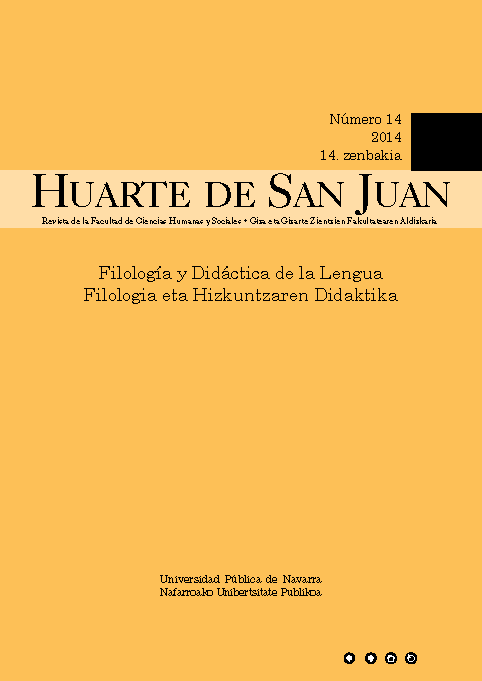Cortesía lingüística: un estudio en el ámbito educativo
Resumen
Aunque la cortesía lingüística sea algo muy analizado en adultos, no ha sido investigada en el ámbito educativo. Este estudio pretende señalar y justificar la necesidad de educar a los jóvenes de secundaria en cortesía lingüística. Al no contar con estudios previos en el aula, ha sido necesario realizar unas actividades de role play para tener referencia de la situación en la que se encuentra la cortesía lingüística en este colectivo. Para ello, alumnos de ESO y Bachillerato han producido conversaciones espontáneas de cuatro diferentes situaciones. El estudio analiza las estrategias optadas y las estructuras construidas. Los resultados demuestran que los chicos y las chicas eligen diferentes estrategias y estructuras para afrontar esas situaciones y que incluso entre los adolescentes son notables las diferencias entre los alumnos de distintas edades. Es decir, tanto el sexo como la edad (etapa evolutiva) de los adolescentes son variables de la cortesía lingüística.
Descargas
Citas
ALCARAZ y MARTÍNEZ (1997): Diccionario de Lingüística Moderna, Ariel.
ANASTASI, A. y FOLEY, J. P. (1958): Differential Psychology, New York, Macmillan.
BALLESTEROS MARTÍN, Francisco José (2003): «La cortesía verbal: análisis pragmático lingüístico de las exhortaciones impositivas en inglés y en español: el ruego y el mandato» (tesis doctoral), en pdf disponible en [http://biblioteca.ucm.es/tesis/19972000/H/3/H3052801.pdf] [consulta, 1 de marzo de 2014].
BRIGGS, C. L. (1986): Learning How to Ask: A Sociolinguistic Appraisal of the Role of the Interview in Social Science Research, Cambridge University Press.
BRIZENDINE, L. (2006): The female brain, Broadway Books.
BROWN, P. y LEVINSON, S. C. ([1978] 1987): Politeness: Some Universals in Language Usage, Cambridge University Press.
BUFFERY, A. W. H.; Gray, J. A.; Ounsted, C. y Taylor, D. C. (1972): Gender Differences: TheirOntogeny and Significance, Churchill Livingstone.
CAMERON, D. (2007): The Myth of Mars and Venus: Do Men and Women Really Speak Different Languages?, Oxford University Press.
CAMPOS PRATS, M. (2010): Los actos disentivos. ¿Cómo expresan su desacuerdo los niños y niñas de primaria y secundaria? Disponible en [http://ibdigital.uib.es/greenstone/collect/memoriesUIB/archives/Campos].
CHAMBERS, J. K. (1995): Sociolinguistic theory, Blackwell.
DENNO, D. (1982): «Sex differences in cognition: A review, and critique of the longitudinal evidence», Adolescence, 17, 779-788.
DUNBAR, R. (1996): Grooming, Gossip, and the Evolution of Language, London, Faber.
ESCANDELL, M.V. (1993): Introducción a la pragmática, Anthropos.
FERNÁNDEZ SÁNCHEZ, J. (2004): «Perspectiva evolutiva: Identidades y desarrollos de comportamientos según el género», Psicología y Género, 35-54.
FISHMAN, P. M.; THORNE, B.; KRAMARAE, C. y HENLEY, N. (1983): «Language, gender and society», Language, Gender and Society, 89-110.
GOFFMAN, E. (1967): Interaction rituals, New York, Garden City.
GRAY, J. (1992). Men Are From Mars, Women Are From Venus, New York, HarperCollins.
GRICE, H. P. (1975): «Logic and conversation, 41-58», Syntax and Semantics, vol. 3, Speech Acts, editado por Peter Cole and Jerry L. Morgan. New York: Academic Press.
HIRSCHMAN, L. (1974): «Analysis of Supportive and Assertive Behavior in Conversations. Paper presented at annual meeting of the Linguistic Society of America, San Francisco, CA», Language, gender and society, Rowley, MA, Newbury House, 1983.
HYDE, J. S. y LINN, M. C. (1988): «Gender differences in verbal ability: A meta-analysis», Psychological Bulletin, 104(1), 53-69.
JESPERSEN, O. (1922): Language: Its nature, origin and development, London, G. Allen & Unwin, Ltd.
KITE, M. E. (2001): «Gender stereotypes», Encyclopedia of Women and Gender: Sex Similarities and Differences and the Impact of Society in Gender, I, 561-570.
LAKKOF, R. (1975): Language and Woman’s place, New York, Harper & Row.
LEECH, G. N. (1980): Explorations in Semantics and Pragmatics, Benjamins.
LEECH, G. N. (1983): Principles of Pragmatics, Longman.
LEVY, K. J. (1976): «Reducing the occurrence of omitted or untruthful responses when testing hypotheses concerning proportions», Psychological Bulletin, 83(5), 759-761.
MACCOBY, E. E. y JACKLIN, C. N. (1974): The Psychology of Sex Differences, Stanford University Press.
PEDROSA, C. (1976): La Psicologia Evolutiva, Marova.
SECADAS, F. y SERRANO, G. (1981): Psicología evolutiva, 14 años, CEAC.
SPENDER, D. (1980): Man Made Language, Routledge.
TANNEN, D. (1990): You Just Don’t Understand: Men and Women in Conversation, HarperCollins.
TANNEN, D.(1994): Gender and discourse, Oxford University Press.
THORNE, B. y HENLEY, N. (1975): Language and Sex: Difference and Dominance, Newbury House Publishers.
ZIMMERMANN, K. S. (2005): «Construcción de la identidad y anticortesía verbal», en D. Bravo (ed.), Estudios sobre la (des)cortesía en español, Dunken, 245-271.
Descargas
Publicado
Cómo citar
Número
Sección
Licencia
Todos los artículos son publicados bajo una licencia de uso y distribución Creative Commons (BY-NC-ND 4.0). A cada artículo se le asignará un identificador DOI.
Los autores conservan los derechos de autor y conceden a la revista el derecho de la primera publicación. Los autores podrán establecer acuerdos adicionales para la distribución no exclusiva de la versión de la obra publicada en la revista (por ejemplo, situarlo en un repositorio institucional), con un reconocimiento de su publicación inicial en esta revista. Los trabajos podrán subirse a repositorios institucionales inmediatamente tras la publicación de la revista.
Asimismo, se permite y se anima a los autores a difundir sus trabajos electrónicamente (por ejemplo, en repositorios institucionales, redes sociales académicas o en su propio sitio web).







